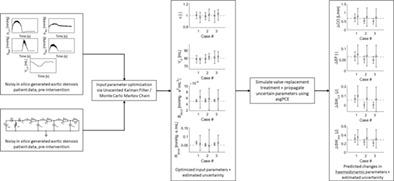当前位置:
X-MOL 学术
›
Int. J. Numer. Method. Biomed. Eng.
›
论文详情
Our official English website, www.x-mol.net, welcomes your feedback! (Note: you will need to create a separate account there.)
Uncertainty in model-based treatment decision support: Applied to aortic valve stenosis.
International Journal for Numerical Methods in Biomedical Engineering ( IF 2.1 ) Pub Date : 2020-07-20 , DOI: 10.1002/cnm.3388 Roel Meiburg 1 , Wouter Huberts 1, 2 , Marcel C M Rutten 1 , Frans N van de Vosse 1
International Journal for Numerical Methods in Biomedical Engineering ( IF 2.1 ) Pub Date : 2020-07-20 , DOI: 10.1002/cnm.3388 Roel Meiburg 1 , Wouter Huberts 1, 2 , Marcel C M Rutten 1 , Frans N van de Vosse 1
Affiliation

|
Patient outcome in trans‐aortic valve implantation (TAVI) therapy partly relies on a patient's haemodynamic properties that cannot be determined from current diagnostic methods alone. In this study, we predict changes in haemodynamic parameters (as a part of patient outcome) after valve replacement treatment in aortic stenosis patients. A framework to incorporate uncertainty in patient‐specific model predictions for decision support is presented. A 0D lumped parameter model including the left ventricle, a stenotic valve and systemic circulatory system has been developed, based on models published earlier. The unscented Kalman filter (UKF) is used to optimize model input parameters to fit measured data pre‐intervention. After optimization, the valve treatment is simulated by significantly reducing valve resistance. Uncertain model parameters are then propagated using a polynomial chaos expansion approach. To test the proposed framework, three in silico test cases are developed with clinically feasible measurements. Quality and availability of simulated measured patient data are decreased in each case. The UKF approach is compared to a Monte Carlo Markov Chain (MCMC) approach, a well‐known approach in modelling predictions with uncertainty. Both methods show increased confidence intervals as measurement quality decreases. By considering three in silico test‐cases we were able to show that the proposed framework is able to incorporate optimization uncertainty in model predictions and is faster and the MCMC approach, although it is more sensitive to noise in flow measurements. To conclude, this work shows that the proposed framework is ready to be applied to real patient data.
中文翻译:

基于模型的治疗决策支持的不确定性:应用于主动脉瓣狭窄。
经主动脉瓣植入 (TAVI) 治疗的患者结果部分依赖于患者的血流动力学特性,而这些特性无法仅通过当前的诊断方法来确定。在这项研究中,我们预测了主动脉瓣狭窄患者瓣膜置换治疗后血流动力学参数的变化(作为患者结局的一部分)。提出了将不确定性纳入决策支持的患者特定模型预测的框架。一个 0D 集总参数模型包括左心室、狭窄瓣膜和全身循环系统,已经基于早先发表的模型开发出来。无迹卡尔曼滤波器(UKF)用于优化模型输入参数以拟合干预前的测量数据。优化后,通过大幅降低阀门阻力来模拟阀门处理。然后使用多项式混沌扩展方法传播不确定的模型参数。为了测试提议的框架,开发了三个具有临床可行性测量的计算机测试用例。在每种情况下,模拟测量的患者数据的质量和可用性都会降低。将 UKF 方法与蒙特卡罗马尔可夫链 (MCMC) 方法进行比较,这是一种众所周知的不确定性预测建模方法。随着测量质量的降低,这两种方法都显示出增加的置信区间。通过考虑三个计算机测试用例,我们能够证明所提出的框架能够在模型预测中结合优化不确定性,并且速度更快,并且 MCMC 方法,尽管它对流量测量中的噪声更敏感。总结一下,
更新日期:2020-07-20
中文翻译:

基于模型的治疗决策支持的不确定性:应用于主动脉瓣狭窄。
经主动脉瓣植入 (TAVI) 治疗的患者结果部分依赖于患者的血流动力学特性,而这些特性无法仅通过当前的诊断方法来确定。在这项研究中,我们预测了主动脉瓣狭窄患者瓣膜置换治疗后血流动力学参数的变化(作为患者结局的一部分)。提出了将不确定性纳入决策支持的患者特定模型预测的框架。一个 0D 集总参数模型包括左心室、狭窄瓣膜和全身循环系统,已经基于早先发表的模型开发出来。无迹卡尔曼滤波器(UKF)用于优化模型输入参数以拟合干预前的测量数据。优化后,通过大幅降低阀门阻力来模拟阀门处理。然后使用多项式混沌扩展方法传播不确定的模型参数。为了测试提议的框架,开发了三个具有临床可行性测量的计算机测试用例。在每种情况下,模拟测量的患者数据的质量和可用性都会降低。将 UKF 方法与蒙特卡罗马尔可夫链 (MCMC) 方法进行比较,这是一种众所周知的不确定性预测建模方法。随着测量质量的降低,这两种方法都显示出增加的置信区间。通过考虑三个计算机测试用例,我们能够证明所提出的框架能够在模型预测中结合优化不确定性,并且速度更快,并且 MCMC 方法,尽管它对流量测量中的噪声更敏感。总结一下,

























 京公网安备 11010802027423号
京公网安备 11010802027423号